COPYRIGHT, PLEASE NOTE
All the material on this website is copyrighted to J-P Metsavainio, if not otherwise stated. Any content on this website may not be reproduced without the author’s permission.
BUY A MUSEUM QUALITY POSTER
BUY A POSTER:https://astroanarchy.zenfolio.com/
Wednesday, January 15, 2020
Firework
I was imaging at December 31. Since my observatory locates at centrum of the city, there was lots of fireworks going on around. One of my 20 min sub frames captured a big one! Image was taken with a Tokina 300mm f2.8 camera lens, 5 nm H-alpha filter and Apogee Alta U16 astronomical camera.
FIREWORK
Click for a large image
H-alpha shot of firework looks kind of neat
Technical details
Processing workflow
Image acquisition, MaxiDL v5.07.
Calibrated in CCDStack2.
Levels and curves in PS CS3.
Imaging optics
Tokina AT-x 300mm f2.8 camera lens
Mount
10-micron 1000
Cameras and filters
Imaging camera Apogee Alta U16 and Apogee seven slot filter wheel
Guider camera, Lodestar x 2 and an old spotting scope of Meade LX200
Astrodon filters,
5nm H-alpha
5nm H-alpha
Total exposure time
H-alpha, 1 x 1200 s, binned 1x1 = 20 min.
Tuesday, January 14, 2020
Deep look to the Heart
I made some testing with my new imaging system based on Tokina AT-x 300mm f2.8 camera lens.
The CCD I'm using has kind of large pixels, 9 microns, so I'm undersampled, the image scale is almost 5 arc seconds / pixel. Undersampling is not a bad thing when my targets are large and dim nebula complexes. This system collects photons very fast!
The CCD I'm using has kind of large pixels, 9 microns, so I'm undersampled, the image scale is almost 5 arc seconds / pixel. Undersampling is not a bad thing when my targets are large and dim nebula complexes. This system collects photons very fast!
I selected the Heart Nebula as a target since I have plenty of reference material for it. Another reason is interesting and rarely imaged area after the bright tip of the heart. There are some remnants of a supernova explosion. I was really thrilled, when I saw the final stack of 12 600s H-alpha light frames. (Equal to 2h of exposures) I never have seen so much background nebulae and details from this popular target.
Beside 2h of H-alpha (Light from an ionized hydrogen) I shot 30 min of O-IIII (Light from an ionized Oxygen) To be able to make an image in visual palette.
The Heart Nebula, IC 1805
Please, click for a large image
Going very deep just in two hours! Image is in visual color palette from emission of an ionized hydrogen and oxygen. R=hydrogen, G=Oxygen and B=oxygen. I have made a starless version out of this image, it can be seen here, https://astroanarchy.blogspot.com/2020/01/an-animated-heart-nebula-ic1805805-with.html
An older image of the area from 2011
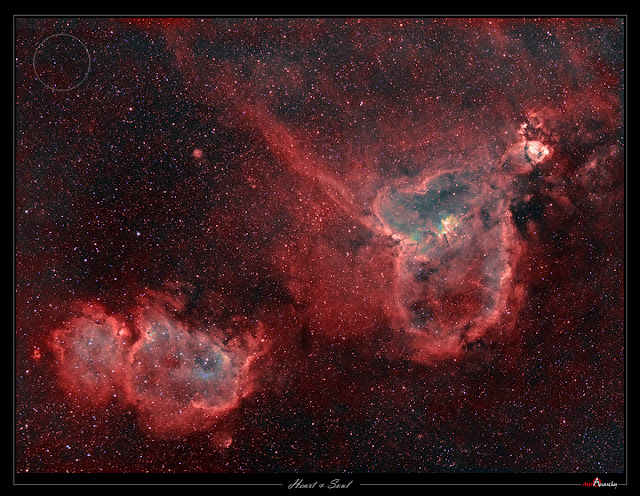
Note, there is a white circle showing an apparent size of the Moon at upper left corner to show the scale in the sky. More info about this older image can be seen here, https://astroanarchy.blogspot.com/2011/05/wide-field-vs-closeups-north-america_21.html
Technical details
Processing workflow
Image acquisition, MaxiDL v5.07.
Stacked and calibrated in CCDStack2.
Deconvolution with a CCDStack2 Positive Constraint, 33 iterations, added at 50% weight
Color combine in PS CS3
Levels and curves in PS CS3.
Imaging optics
Tokina AT-x 300mm f2.8 camera lens
Mount
10-micron 1000
Cameras and filters
Imaging camera Apogee Alta U16 and Apogee seven slot filter wheel
Guider camera, Lodestar x 2 and an old spotting scope of Meade LX200
Astrodon filters,
5nm H-alpha 3nm S-II and 3nm O-III
5nm H-alpha 3nm S-II and 3nm O-III
Total exposure time
H-alpha, 12 x 600 s, binned 1x1 = 2 h
O-III, 3x 600 s, binned 1x1 = 30 min..
O-III, 3x 600 s, binned 1x1 = 30 min..
Second light for my wide field imaging system
At January 10. I shot few lights for this busy area in Cassiopeia from the Bubble Nebula to Cave nebula. The Tokina 300mm AT-x f2.8 camera lens combined to Apogee Alta U16 camera is a very good to capturing photons. The combination of fast f2.8 optics and 9 micron pixels, (4096 x 4096 pixels) goes very deep very fast. (First light photo here, https://astroanarchy.blogspot.com/2020/01/first-light-for-winter-season-2019-20.html)
From Bubble to Cave Nebula
Please, click for a large image!
Image is in mapped colours, from the emission of ionized elements, R=Sulphur, G=Hydrogen and B=Oxygen. The signal for ionized oxygen,.
No Stars
Please, click for a large image!
Please, click for a large image!
An experimental starless image to show the actual nebula formation better.
Orientation
Please, click for a large image!
The area of the new photo is marked as a white rectangle. Info about this image here, https://astroanarchy.blogspot.com/2014/01/a-grande-finale-of-cepheus-project.html
Technical details
Processing workflow
Image acquisition, MaxiDL v5.07.
Stacked and calibrated in CCDStack2.
Deconvolution with a CCDStack2 Positive Constraint, 33 iterations, added at 50% weight
Color combine in PS CS3
Levels and curves in PS CS3.
Imaging optics
Tokina AT-x f2.8 camera lens
Mount
10-micron 1000
Cameras and filters
Imaging camera Apogee Alta U16 and Apogee seven slot filter wheel
Guider camera, Lodestar x 2 and an old spotting scope of Meade LX200
Astrodon filters,
5nm H-alpha 3nm S-II and 3nm O-III
5nm H-alpha 3nm S-II and 3nm O-III
Total exposure time
H-alpha, 18 x 600 s, binned 1x1 = 2,5 h
O-III, 6x 600 s, binned 1x1 = 1 h.
S-II, 2 x 600 s. binned 1x1 = 20 min.
Labels:
Narrowband color images,
nebula
Monday, January 13, 2020
The Frankenstein monster, my current imaging setup
First time at this Winter season 2019-20 I have a clear sky and somehow functional imaging system.
I managed to mate Apogee Alta U16 + filter wheel with my old second hand Tokina AT-x 300mm f2.8 camera lens.
Lots of self made mechanical tweaks was needed to make this work out.. (I used even an angle grinder to cut off ”unnecessary” parts of the lens to have correct back focus distance)
The result looks more like a Frankenstein monster. It’s alive!!!
"New" imaging setup
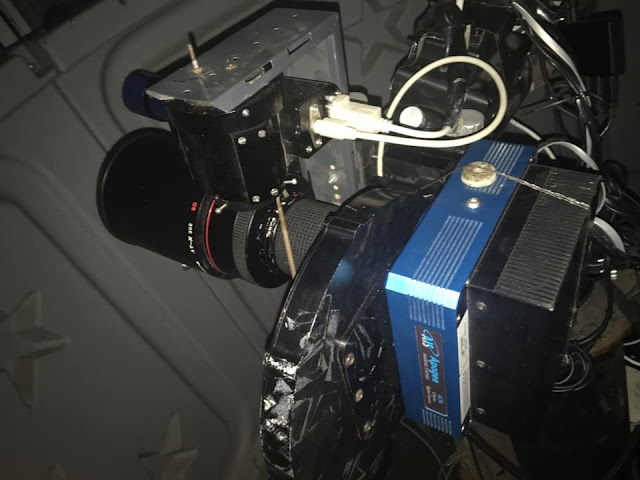
Apogee Alta U16 with a filter wheel and Tokina AT-x f2.8 camera lens n th 10-micron 1000 mount.
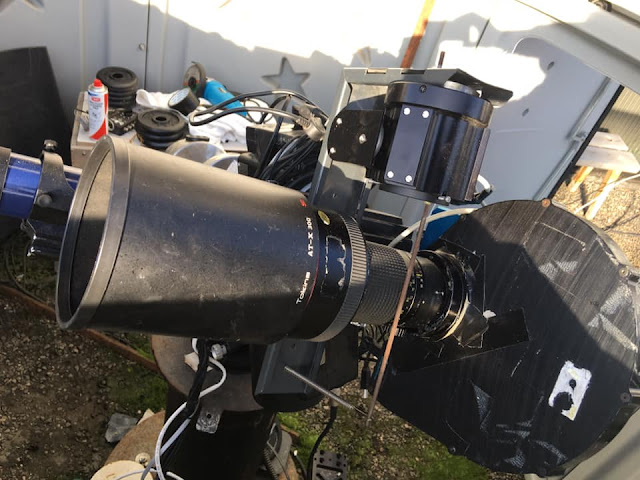
The focusing system is build around the TCF-s focuser. Focusing is done by a spring loaded round metal file over the focusing ring. This is a very accurate autofocusing system and it's temperature compensating too.
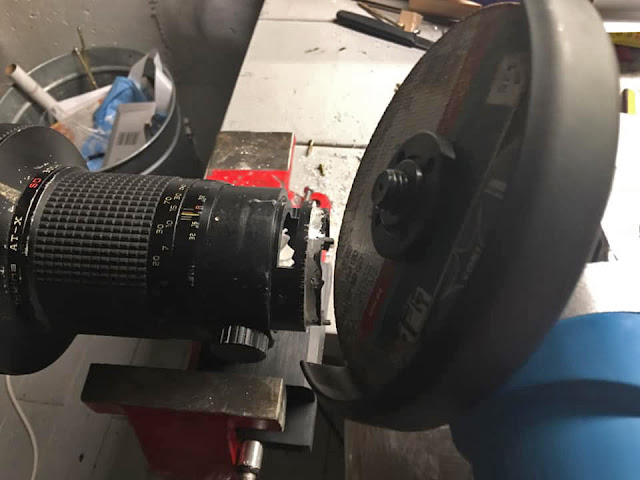
Shortening the lens, bajonet and aperture control ring are removed and I'm just about to cutting off the filter holder area. The current imaging system is kind of crazy combination. Actually it shouldn't work at all but with a angle grinder and self made adapter I was able to mate Tokina AT-x 300mm f2.8 optics to Apogee Alta U16 camera and filter wheel. There is also a temp compensating focusing system made from TCF-s focuser, L-shape metal from an old table, round metal file and a spring from an old desk lamp. The CCD is very large, over 36 x 36 mm but for some reason the lens can lit the whole area with a very little coma at most outer corners.
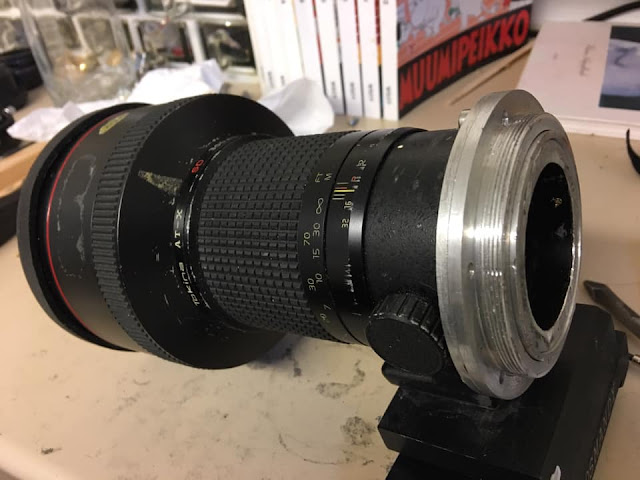
Self made adapter for the Apogee filter wheel attached.
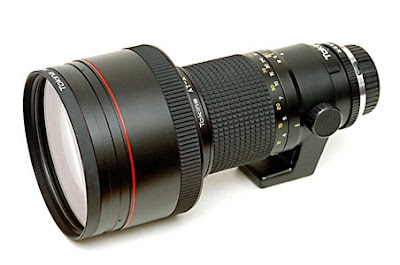
Original untouched lens.
First light photo for this system
Image analysis with CCDinspector
Click for a large image
This works way better than I thought! The whole oversize CCD is lit, there are some coma at corners but it'll be easy to crop out by removing narrow areas from left and right or from up and bottom.
Image of the full uncropped frame
(reduced 50% due to large size)
Image of the full uncropped frame
(reduced 50% due to large size)
Labels:
equipments,
Tokina 300mm f2.8 images
Subscribe to:
Comments (Atom)
















